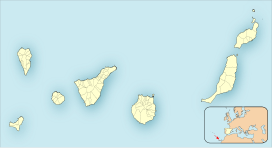geo.wikisort.org - Mountains
Pico de las Nieves is the second highest peak on the island of Gran Canaria, Canary Islands, Spain. Its height is 1,949 metres (6,394 ft) above sea level. It is of volcanic origin (stratovolcano). On its slopes, Canary Islands Pine was reintroduced in the 1950s.[citation needed]
| Pico de las Nieves | |
|---|---|
 | |
| Highest point | |
| Elevation | 1,949 m (6,394 ft)[1] |
| Prominence | 1,949 m (6,394 ft)[1] |
| Listing | Ultra |
| Coordinates | 27°57′43″N 15°34′18″W[1] |
| Geography | |
 Pico de las Nieves Location in the Canary Islands, on the island of Gran Canaria | |
| Location | Gran Canaria, Canary Islands, Spain |
| Geology | |
| Mountain type | Stratovolcano |
Traditionally, Pico de las Nieves has been considered the highest peak on the island of Gran Canaria; however, this is uncertain since Morro de la Agujereada stands at 1,956 metres (6,417 ft), which would make it higher than Pico de las Nieves.[2] The two mountains stand next to each other.
Gran Canaria has the highest elevation of the province of Las Palmas and the third highest in the Canary Islands. Of the other Canary Islands, only Tenerife and La Palma have higher peaks.
Name
This section does not cite any sources. (September 2019) |
The name means 'peak of the snows' in Spanish and refers to the fact that several covered pits (neveras in Spanish) for holding snow were built directly into the mountainsides. (An alternative theory states that the name came about as the mountain had the highest frequency of snowfalls on the island.) The first of the neveras was constructed in 1694 by order of the Catholic Church. The snow was collected by laborers using wooden shovels and wicker baskets, making real mountains of snow. The snow was placed into the pits by the "paleros" in rows, and packed in rectangular boxes of wood or cork separated by layers of straw.
There were many blocks of ice, called "sabanada", which in June would be carried in panniers of straw covered with blankets to the ice cream shop in the Cathedral of Las Palmas (the capital of the island) on horseback, which took five or six hours. The snow was used for alleviating disease, to lower the temperature in the epidemics of yellow fever and cholera, as well as an anti-inflammatory and analgesic. It was also used for cooling water or beverages for the upper class. Water from the pools was used for irrigation purposes.
Sights
Most of the highest plateau is occupied by a military base, including a large ball-shaped radar. Civilian visitors are allowed to enter a platform somewhat below the base, from which half of the island as well as Tenerife's Pico del Teide is visible, in case of good weather. The most distinctive feature is the Roque Nublo monolith, the second highest peak of the island.
The peak could be accessed by a car, as there is a road used by the army. The peak is located between the municipalities of Tejeda, Vega de San Mateo and San Bartolome de Tirajana.
References
- "Europe: Atlantic Islands - Ultra Prominences" Peaklist.org. Retrieved 2011-12-18.
- La tecnología destrona al Pico de las Nieves como techo de la isla
На других языках
[de] Pico de las Nieves
Der Pico de las Nieves ist mit 1949 Metern über dem Meeresspiegel die zweithöchste Erhebung der spanischen Insel Gran Canaria. Der Gipfel befindet sich auf der Spitze eines erloschenen Vulkans im dünn besiedelten Inselinnern. Im Winter ist diese Erhebung manchmal schneebedeckt, was ihr zu ihrem Namen verholfen hat.- [en] Pico de las Nieves
[es] Pico de las Nieves
El Pico de las Nieves es una montaña de la isla de Gran Canaria ―Canarias, España―, siendo la segunda en altitud con 1948 msnm.[1][fr] Pic de las Nieves
Le pic de las Nieves (en espagnol pozo ou pico de las Nieves signifiant « pic des Neiges ») est le deuxième plus haut sommet de l'île de Grande Canarie, dans les îles Canaries, avec une altitude de 1 950 mètres. Il est situé sur le tripoint des territoires des communes de San Bartolomé de Tirajana, Tejeda et Vega de San Mateo.[it] Pico de las Nieves
Il Pico de las Nieves è la seconda montagna più alta dell'isola di Gran Canaria, raggiunge l'altezza di 1949 sul livello del mare.[ru] Ньевес
Ньевес[2] (исп. Pico de las Nieves, буквально — «Снежная вершина») — гора вулканического происхождения на острове Гран-Канария, Канарские острова.Другой контент может иметь иную лицензию. Перед использованием материалов сайта WikiSort.org внимательно изучите правила лицензирования конкретных элементов наполнения сайта.
WikiSort.org - проект по пересортировке и дополнению контента Википедии

